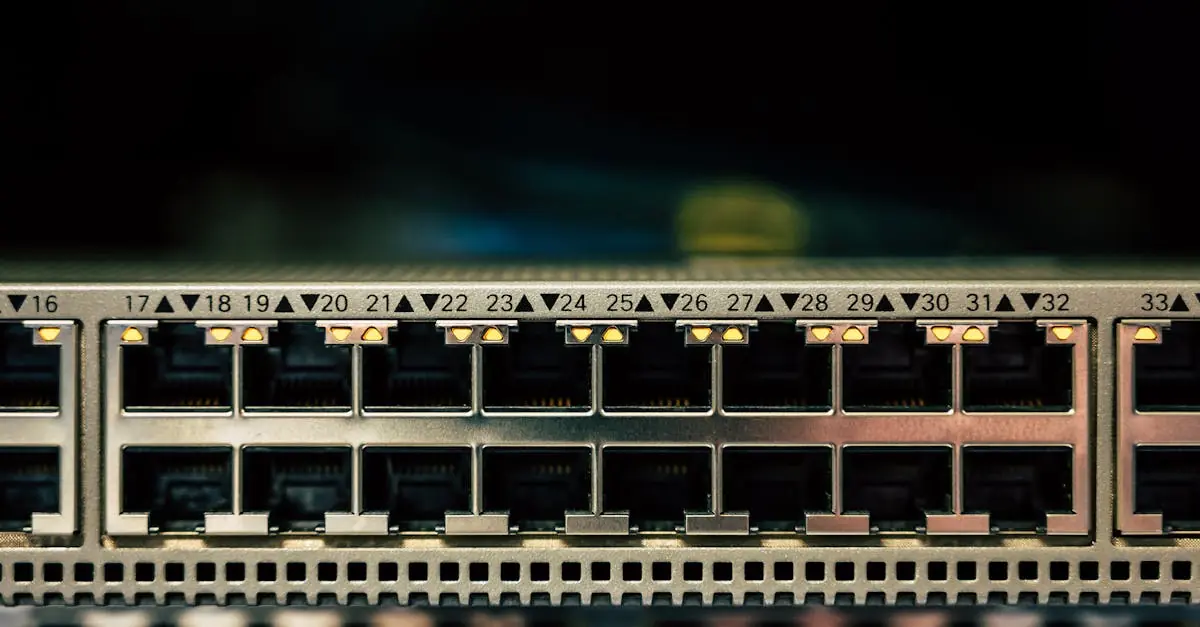In a world where Wi-Fi reigns supreme, LAN ports might seem like the forgotten heroes of connectivity. But let’s not underestimate these little rectangles of magic. They’re the unsung champions that deliver lightning-fast internet speeds and rock-solid connections, all while your Wi-Fi signal plays hide-and-seek with your devices.
Table of Contents
ToggleOverview Of LAN Ports
LAN ports, or Local Area Network ports, enable wired connections between devices. These ports facilitate data transfer in a targeted, efficient manner. Devices connecting via LAN ports include computers, printers, and gaming consoles. Ethernet cables commonly connect these devices to routers, offering stable connectivity.
Reliability defines LAN ports, primarily due to their minimal interference compared to Wi-Fi. This interference arises from various factors including distance and physical obstacles. Industries that require unbroken internet access, such as financial institutions and media production companies, rely on LAN ports to maintain consistent connectivity.
Speed represents another significant benefit of using LAN ports. Network speeds can reach up to 1 Gbps with Gigabit Ethernet technology. Users engaged in bandwidth-heavy activities, like video streaming or online gaming, experience smoother performance when connected through LAN ports.
Security also stands out as an advantage of LAN port connections. Wired networks pose fewer risks from outside threats, like hacking, than their wireless counterparts. Securing sensitive data is especially critical for businesses and organizations relying on LAN connections.
LAN ports offer vital features for reliable networking. Enhanced speed, security, and stability make LAN connections preferable for various applications. Avoiding internet dropouts, reducing latency, and maintaining high throughput represent key priorities for users and businesses alike.
Types Of LAN Ports
LAN ports come in various types, each serving specific connectivity needs in different environments. Two primary types include Ethernet ports and fiber optic ports.
Ethernet Ports
Ethernet ports are the most common LAN ports found in homes and businesses. These ports support wired connections using standard Ethernet cables, allowing devices such as computers, routers, and printers to communicate efficiently. Gigabit Ethernet technology enables speeds up to 1 Gbps, ensuring smooth data transfers for online gaming, video conferencing, and heavy downloads. Devices equipped with Ethernet ports deliver stable connections with minimal interference, making them ideal for settings that require consistent internet access. Networking hardware often includes multiple Ethernet ports, providing flexibility when connecting various devices together.
Fiber Optic Ports
Fiber optic ports offer a more advanced alternative for LAN connections. These ports utilize thin strands of glass or plastic fibers to transmit data as light signals, allowing for incredibly high speeds and broader bandwidth. Capable of supporting speeds exceeding 1 Gbps, fiber optic connections excel in data-intensive applications such as streaming ultra-high-definition video and transferring large volumes of data. Security benefits also come into play, as fiber optic cabling is less susceptible to interference and eavesdropping. Businesses requiring high reliability often turn to fiber optic ports for their internet needs, enhancing overall network performance and user experience.
Benefits Of Using LAN Ports
LAN ports offer numerous advantages, particularly in speed, performance, reliability, and stability. These benefits make wired connections essential for various applications.
Speed And Performance
LAN ports deliver superior speed, often reaching up to 1 Gbps with Gigabit Ethernet technology. Users engaged in bandwidth-heavy activities, such as online gaming and video streaming, greatly benefit from this capability. Fast data transfer rates reduce buffering and ensure a smoother experience. Utilizing wired connections minimizes latency, making them preferable for real-time communications. Consequently, businesses that rely on consistent performance gain an edge over competitors relying solely on Wi-Fi.
Reliability And Stability
Reliability defines LAN ports, providing a consistent internet connection. Wired connections experience minimal interference compared to Wi-Fi, which suffers from distance and physical obstacles. Such stability is crucial for industries that require uninterrupted access to data. For example, financial institutions depend on reliable connections to process transactions securely. Therefore, adopting LAN ports enhances overall connectivity while reducing the likelihood of network dropouts, which can disrupt essential operations.
LAN Ports Versus Other Connection Types
LAN ports offer unique advantages when compared to other connection types. They provide stability and reliability, essential for tasks that require constant internet access.
Comparison With Wi-Fi
Wi-Fi connectivity excels in convenience but fluctuates in reliability and speed. Interference from distance and obstacles can hinder performance. In contrast, LAN ports ensure a consistent 1 Gbps connection, making them ideal for high-demand activities like online gaming or video conferencing. Users can count on lower latency with wired connections, enhancing real-time communications. Businesses prioritizing performance often lean toward LAN connections to avoid disruptions in service.
Comparison With USB Connections
USB connections primarily serve device interconnectivity, providing power and data transfer capabilities. They facilitate direct connections between peripherals and computers, but lack the extensive network capabilities of LAN ports. LAN ports deliver greater bandwidth, supporting multiple devices simultaneously without compromising speed. While USB can transfer data at impressive rates, it cannot match the sustained performance of wired networks in bandwidth-heavy environments. Organizations focused on efficiency often favor LAN ports for their broader networking capabilities.
Common Issues With LAN Ports
LAN ports can experience a variety of issues that disrupt connectivity. One common problem arises from physical damage to Ethernet cables. Frayed or bent cables lead to intermittent connections, making it essential to inspect them regularly.
Another issue concerns improper configuration settings. Users often overlook the importance of configuring network settings correctly, which can result in connectivity failures. Verifying the settings and ensuring that devices are correctly linked to the network can mitigate these problems.
Occasionally, a faulty LAN port causes connection issues. Signs of a defective port include inconsistent speeds or inability to establish a connection. Plugging the Ethernet cable into another port on the router typically identifies whether the port is the source of the problem.
IP address conflicts also pose challenges for users. When two devices share the same IP address on a network, connectivity issues arise. Assigning unique IP addresses to each device resolves such conflicts and restores stable connections.
Moreover, outdated drivers can hinder the performance of LAN ports. Keeping the network adapter drivers updated ensures that systems maintain optimal functionality. Regular updates can address bugs and improve overall performance.
Network congestion often leads to reduced speeds. High demand for bandwidth-heavy activities, like video streaming or gaming, can overwhelm the network. Implementing Quality of Service (QoS) settings on routers prioritizes critical traffic and enhances overall performance.
Understanding these potential issues with LAN ports helps users maintain a stable and reliable network experience. Users can troubleshoot effectively with proactive measures and regular maintenance of their network equipment.
Conclusion
LAN ports play a crucial role in ensuring reliable and high-speed internet connections. Their ability to provide stable connectivity makes them an essential choice for both personal and professional use. With the increasing demand for bandwidth-intensive applications, the advantages of using LAN ports become even more apparent.
As technology continues to evolve, the importance of maintaining a robust wired network should not be underestimated. Users can enhance their overall internet experience by leveraging the speed and security offered by LAN ports. Regular maintenance and awareness of potential issues will further optimize performance, making LAN connections a smart investment for anyone looking to improve their network reliability.







